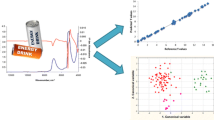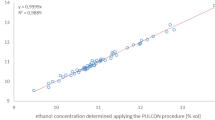Abstract
There is an increasing trend of nonalcoholic beer intake that motivates an effort to improve its taste. This study was conducted to assess the main differences in the polar and mid-polar chemical profile between alcoholic and nonalcoholic beers. A set of differential compounds was characterized through a metabolomics approach with ultraperformance liquid chromatography and mass spectrometry (UPLC-MS) measurements with further data analysis by partial least square discriminant analysis (PLS-DA). Anhydrohexose, a disaccharide, and myoinositol along with phenylalanine, tyramine, and some hop α-acids (desdimethyl-hexahydro/octahydro-iso-cohumulone, tetrahydro-n/ad-humulone, and iso-n/ad-humulone) were shown as the main compounds stablishing differences in the chemical profile between alcoholic and nonalcoholic beers. Further analysis by principal components (PCA) using the content of the selected compounds clearly separated the alcoholic and nonalcoholic beers as well as different brands within these two groups. Cluster analysis provided a clear view of the similarity between the diverse beer brands but with slightly different outcomes to the PCA. Results of this study are expected to help breweries to improve the nonalcoholic beer taste.





Similar content being viewed by others
References
Andrés-Iglesias C, Blanco CA, Blanco J, Montero O (2014) Mass spectrometry-based metabolomics approach to determine differential metabolites between regular and non-alcohol beers. Food Chem 157:205–212
Andrés-Iglesias C, García-Serna J, Montero O, Blanco CA (2015) Simulation and flavor compound analysis of dealcoholized beer via one-step vacuum distillation. Food Res Int 76:751–760
Blanco CA, Andrés-Iglesias C, Montero O (2016) Low-alcohol beers: flavour compounds, defects and improvement strategies. Crit Rev Food Sci Nutr 56:1379–1388
Bligh EG, Dyer WJ (1959) A rapid method of total lipid extraction and purification. Can. J Biochem Physiol 37(1):911–917
Bravi E, Marconi O, Sileoni V, Perretti G (2017) Determination of free fatty acids in beer. Food Chem 215:341–346
Cajka T, Riddellova K, Tomaniova M, Hajslova J (2011) Ambient mass spectrometry employing a DART ion source for metabolomics fingerprinting/profiling: a powerful tool for beer origin recognition. Metabolomics 7:500–508
Catarino M, Ferreira A, Mendes A (2009) Study and optimization aroma recovery from beer by pervaporation. J Membr Sci 341:51–59
Česlová L, Holčapek M, Fidler M, Drštičková J, Lísa M (2009) Characterization of prenylflavonoids and hop bitter acids in various classes of Czech beers and hop extracts using high-performance liquid chromatography-mass spectrometry. J Chromatogr A 1216:7249–7257
Codoñer-Franch P, Hernández-Aguila MT, Navarro-Ruiz A et al (2013) Nonalcoholic beer increases antioxidant properties of breast milk. Breastfeed Med 8:164–169
Dack RE, Black GW, Koutsidis G, Usher SJ (2017) The effect of Maillard reaction products and yeast strain on the synthesis of key higher alcohols and esters in beer fermentations. Food Chem 232:595–601
Eriksson L, Johansson E, Kottanech-Wold N et al (2006) Multi- and megavariate data analysis part I: basic principles and applications, 2nd edn. Unmetrics AB, Umeå
Farag MA, Porzel A, Schmidt J, Wessjohann L (2012) Metabolite profiling and fingerprint of commercial cultivars of Humulus lupulus L. (hop): a comparison of MS and NRM methods in metabolomics. Metabolomics 8:492–507
Ghiselli A, Natella F, Guidi A, Montanari L, Fantozzi P, Scaccini C (2000) Beer increases plasma antioxidant capacity in humans. J Nutr Biochem 11:76–80
Gonçalves JL, Figueira JA, Rodrigues FP et al (2014) A powerful methodological approach combining headspace solid phase microextraction, mass spectrometry and multivatiate analysis for profiling the volatile metabolomic pattern of beer starting raw materials. Food Chem 16:266–280
González-San José ML, Rodríguez PM, Valls-Bellés V (2017) Beer and its role in human health. In: Frias J, Martinez-Villaluenga C, Peñas E (eds) Fermented Foods in Health and Disease Prevention. Academic Press, London, pp 365–384
Heuberger AL, Broeckling CD, Lewis MR, Salazar L, Bouckaert P, Prenni JE (2012) Metabolomic profiling of beer reveals effect of temperature on non-volatile small molecules during short-term storage. Food Chem 135:1284–1289
Kabelova I, Dvoráková M, Čížková H et al (2008) Determination of free amino acids in beers: a comparison of Czech and foreign brands. J Food Compos Anal 21:736–741
Lehnert R, Novák P, Macieira F, Kuřec M, Teixeira J, Branyik T (2009) Optimisation of lab-scale continuous alcohol-free beer production. Czech J Food Sci 27:267–275
Pereira HV, Amador VS, Sena MM, Augusti R, Piccin E (2016) Paper spray mass spectrometry and PLS-DA improved by variable selection for the forensic discrimination of beers. Anal Chim Acta 940:104–112
Possemiers S, Bolca S, Grootaert C, Heyerick A, Decroos K, Dhooge W, de Keukeleire D, Rabot S, Verstraete W, van de Wiele T (2006) The prenylflavonoid Isoxanthohumol from hops (Humulus lupulus L.) is activated into the potent phytoestrogen 8-prenylnaringenin in vitro and in the human intestine. J Nutr 136:1862–1867
Ristivojević P, Morlock G (2018) Effect-directed classification of biological, biochemical and chemical profiles of 50 German beers. Food Chem 260:344–353
Rivero D, Pérez-Magariño S, González-Sanjosé ML, Valls-Belles V, Codoñer P, Muñiz P (2005) Inhibition of induced DNA oxidative damage by beers: correlation with the content of polyphenols and melanoidins. J Agric Food Chem 53:3637–3642
Šedo O, Mářová I, Zdráhal Z (2012) Beer fingerprinting by matrix-assisted laser desorption-ionisation-time of flight mass spectrometry. Food Chem 135:473–478
Sohrabvandi S, Mousavi SM, Razavi SH, Mortazavian AM, Rezaei K (2010) Alcohol-free beer: methods of production, sensorial defects, and healthful effects. Food Rev Int 26:335–352
Spevacek AR, Benson KH, Bamforth CW, Slupsky CM (2016) Beer metabolomics: molecular details of the brewing process and the differential effects of late and dry hopping on yeast purine metabolism. J Inst Brew 122:21–28
Steenackers B, De Cooman L, De Vos D (2015) Chemical transformations of characteristic hop secondary metabolites in relation to beer properties and the brewing process: A review. Food Chem 172:742–756
Tang K, Li Q (2017) Biochemistry of wine and beer fermentation. In: Sanromán MA, Du G, Soccol CR, Dussap CG (eds) Current Developments in Biotechnology and Bioengineering: Food and Beverages Industry. Elsevier, Amsterdam, pp 281–304
Vanhoenacker G, Keukeleire D, Sandra P (2004) Analysis of iso-α-acids and reduced iso-α-acids in beer by direct injection and liquid chromatography with ultraviolet absorbance detection or with mass spectrometry. J Chromatogr A 1035:53–61
Acknowledgements
Marta Velasco is thanked for her excellent technical assistance. The Instituto para la Competitividad Empresarial de Castilla y León (ICECyL) is greatly acknowledged for its laboratory facilities at Boecillo’s Technological Park Bioincubator.
Funding
Financial support from the Junta de Castilla y León (VA332A12-2) is gratefully acknowledged.
Author information
Authors and Affiliations
Corresponding author
Ethics declarations
Conflict of Interest
Cristina Andrés-Iglesiasa declares that she has no conflict of interest. Carlos A. Blanco declares that he has no conflict of interest. Olimpio Montero declares that he has no conflict of interest.
Ethical Approval
This article does not contain any studies with human participants or animals performed by any of the authors.
Informed Consent
Informed consent was obtained from all individual participants included in the study as authors of it.
Electronic supplementary material
ESM 1
(PDF 96 kb)
Rights and permissions
About this article
Cite this article
Andrés-Iglesias, C., Blanco, C.A. & Montero, O. Sugar, Hop α-Acid, and Amino Acid Contents Contribute to the Differential Profile Between Nonalcoholic and Alcoholic Beers. Food Anal. Methods 12, 59–68 (2019). https://doi.org/10.1007/s12161-018-1338-3
Received:
Accepted:
Published:
Issue Date:
DOI: https://doi.org/10.1007/s12161-018-1338-3




